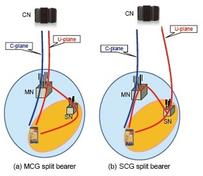ng-eNB vs gNB: Differences in 5G NG-RAN
Advertisement
This page compares ng-eNB vs gNB and mentions the difference between ng-eNB and gNB Base Station types used in 5G NG-RAN (Next Generation Radio Access Network).
Introduction
With the advancement in cellular technologies, RAN architectures have evolved. In 5G NR (New Radio), NG-RAN performs various functions such as packet processing, baseband processing (i.e., Physical layer processing), radio signal processing, and radio resource control, etc. NG-RAN configures and scales RAN nodes dynamically through software.
Signaling and data transport parts are logically separated in NG-RAN and are known as the control plane and user plane, respectively. NG-RAN architecture is flexible, and hence RAN nodes are deployed based on spectrum efficiency and network performance requirements.
ng-eNB | Next Generation e-NodeB
It is an enhanced version of the 4G eNodeB. The ng-eNB connects 5G user equipment (UE) to the 5G CN (Core Network) using the 4G LTE air interface.

As shown in Figure 1, UE (User Equipment) uses 4G LTE radio resources to connect with ng-eNB. It provides E-UTRAN UP (User Plane) and CP (Control Plane) terminations towards the UE. It connects with NG-Core via the NG interface.
During the initial transition and deployment phase of 5G NR (New Radio), 4G networks are available everywhere. There will be many localities where there will not be 5G coverage, and the only coverage available will be using the 4G LTE network. In such locations, ng-eNBs allow 5G subscribers to connect using the 4G air interface with the 5G NG-core to avail 5G services.
gNB | Next Generation NodeB
The gNB is a radio node that is the equivalent of eNB in 4G architecture. The gNB allows 5G UE to connect with the 5G NG core using the 5G NR air interface.

The gNB provides 5G NR User Plane and Control Plane terminations towards the UE. It connects with NG-Core via the NG interface.
The gNB houses three functional modules: CU (Control Unit), DU (Distributed Unit), and Radio Unit (RU). The gNB-CU takes care of MC (mobility control), RRM (Radio Resource Management), and SM (Session Management). The gNB-DU provides PHY and MAC layer functionalities. The functionality split between CU and DU is implementation dependent.
The gNB-DUs and gNB-CU are interfaced using the F1 interface. The F1 interface supports signaling exchange and data transmission between these units (i.e., DU and CU).
Two gNB nodes communicate with each other using the Xn interface.
 RF
RF


